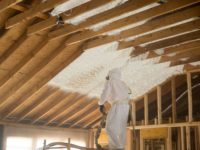New LEED Standard Library Protected by InsulBloc Spray Foam Insulation
One of Norfolk State University’s largest new
building projects, the 132,000-square-foot Lyman Beecher Brooks Library,
promises to be a healthier and more comfortable place to study, learn and meet,
thanks to help from InsulBloc
spray foam insulation by NCFI
Polyurethanes.

MOUNT AIRY, N.C. - One of Norfolk State University’s largest new building projects, the 132,000-square-foot Lyman Beecher Brooks Library, promises to be a healthier and more comfortable place to study, learn and meet, thanks to help from InsulBloc spray foam insulation by NCFI Polyurethanes.
The library was designed by Moseley Architects and built by S.B. Ballard Construction to LEED standards to reduce energy and water use, improve indoor air quality, and promote the wise use of materials. The design also called for increased wall and roof insulation to reduce energy costs.
Frank Hughes, insulation specialist with Applied Energy Saving Systems (AESS), the Mount Pleasant, S.C.-based firm selected to insulate the library, says more architects, like Moseley, are specifying spray foam insulation.
“Spray foam has an exceptional R-value (thermal resistance value), 100 percent adhesion, is monolithic so there are no seams, fills cracks and crevices and leaves no air space when it cures, is an air barrier so no pollen, dust, or other airborne things get through, and it’s closed-cell meaning no water can get through it,” Hughes said. “Plus, on this job there is a beautiful gradual radius turn (curved walls), and only spray foam can accommodate that.”
Hughes said his company chose InsulBloc because “it’s applicator-friendly, works great on masonry cavity walls like this library, it’s a clean product - NCFI’s QC is unrivaled - and the technical support they offer applicators and builders is the best I’ve seen in the industry.” Hughes has been working in closed cell insulation since 1979, and his firm, AESS, is an industry excellence award winner.
Mitch Clifton, manager with NCFI, said the library, which is scheduled to open its’ doors in November, will host a circulating collection of 500,000 volumes, group study rooms, and an Internet café.
“Frank and AESS sprayed 2.5 inches of InsulBloc on the exterior and that will certainly help lower their energy costs, improve indoor air quality and provide a consistently comfortable environment for students and faculty,” Hughes said.
The library’s other green features will include: low-emissivity glazing; ample daylight to reduce dependence on electric lighting; carbon dioxide sensors to assist in providing adequate ventilation; pervious pavers to decrease the quantity of storm runoff from the site; reflective standing-seam metal roofing to prevent the Heat Island Effect and reduce building cooling loads; and dual-flush toilets, 0.125 gallon-per-flush urinals, and 0.5 gallon-per-minute lavatories, which contribute to a water use reduction of over 50 percent. For more information, visit www.NCFI.com.

MOUNT AIRY, N.C. - One of Norfolk State University’s largest new building projects, the 132,000-square-foot Lyman Beecher Brooks Library, promises to be a healthier and more comfortable place to study, learn and meet, thanks to help from InsulBloc spray foam insulation by NCFI Polyurethanes.
The library was designed by Moseley Architects and built by S.B. Ballard Construction to LEED standards to reduce energy and water use, improve indoor air quality, and promote the wise use of materials. The design also called for increased wall and roof insulation to reduce energy costs.
Frank Hughes, insulation specialist with Applied Energy Saving Systems (AESS), the Mount Pleasant, S.C.-based firm selected to insulate the library, says more architects, like Moseley, are specifying spray foam insulation.
“Spray foam has an exceptional R-value (thermal resistance value), 100 percent adhesion, is monolithic so there are no seams, fills cracks and crevices and leaves no air space when it cures, is an air barrier so no pollen, dust, or other airborne things get through, and it’s closed-cell meaning no water can get through it,” Hughes said. “Plus, on this job there is a beautiful gradual radius turn (curved walls), and only spray foam can accommodate that.”
Hughes said his company chose InsulBloc because “it’s applicator-friendly, works great on masonry cavity walls like this library, it’s a clean product - NCFI’s QC is unrivaled - and the technical support they offer applicators and builders is the best I’ve seen in the industry.” Hughes has been working in closed cell insulation since 1979, and his firm, AESS, is an industry excellence award winner.
Mitch Clifton, manager with NCFI, said the library, which is scheduled to open its’ doors in November, will host a circulating collection of 500,000 volumes, group study rooms, and an Internet café.
“Frank and AESS sprayed 2.5 inches of InsulBloc on the exterior and that will certainly help lower their energy costs, improve indoor air quality and provide a consistently comfortable environment for students and faculty,” Hughes said.
The library’s other green features will include: low-emissivity glazing; ample daylight to reduce dependence on electric lighting; carbon dioxide sensors to assist in providing adequate ventilation; pervious pavers to decrease the quantity of storm runoff from the site; reflective standing-seam metal roofing to prevent the Heat Island Effect and reduce building cooling loads; and dual-flush toilets, 0.125 gallon-per-flush urinals, and 0.5 gallon-per-minute lavatories, which contribute to a water use reduction of over 50 percent. For more information, visit www.NCFI.com.
Looking for a reprint of this article?
From high-res PDFs to custom plaques, order your copy today!





